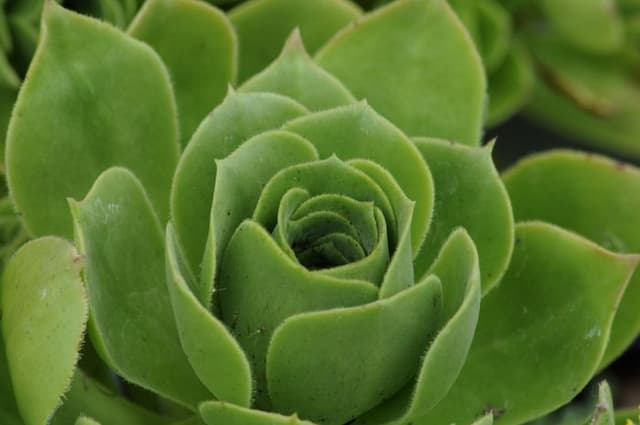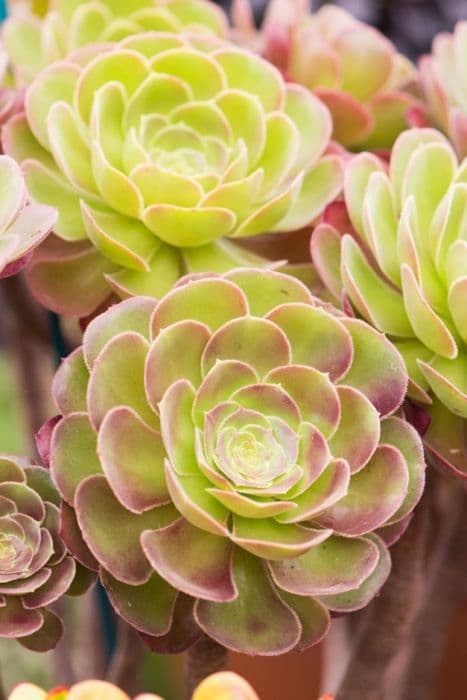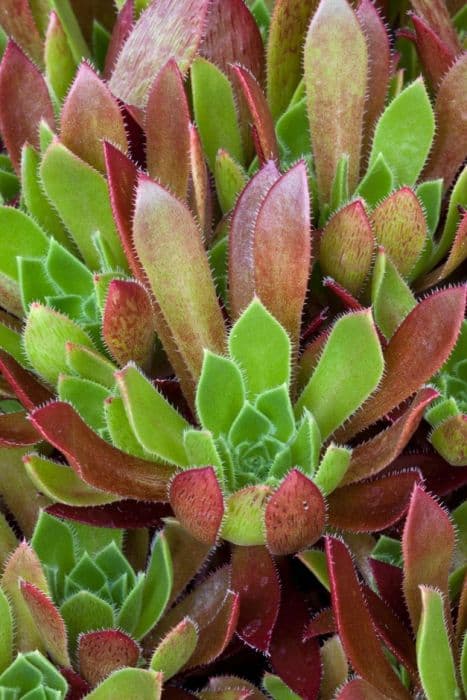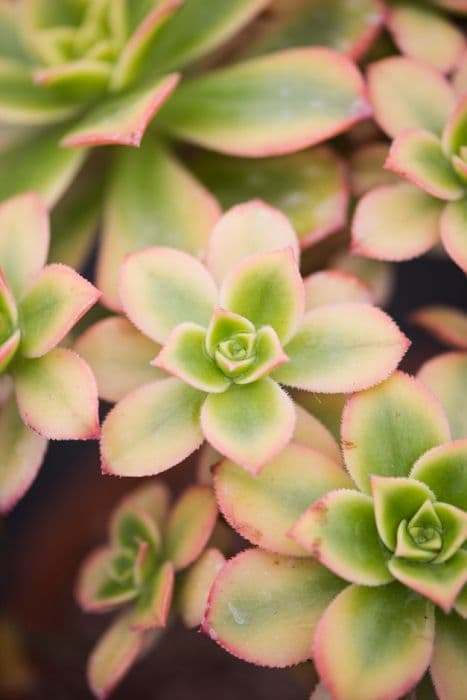Houseleek Sempervivum calcareum 'Extra'

ABOUT
The Sempervivum calcareum 'Extra', commonly known as Hen and Chicks, is a striking succulent that boasts a beautiful rosette shape. Its leaves are thick and fleshy, arranged in a symmetrical pattern emanating from the center of the rosette. The leaves display a stunning color gradient, typically showcasing a green hue at the base that transitions to a purple or reddish tinge at the tips. This distinct coloration is accentuated by the contrasting, often lighter-hued lines, or "watermarks", that run along the outer edges of the leaves, giving the plant a unique and eye-catching appearance. The leaves themselves may have a slightly pointed tip and a somewhat rigid texture, which helps them to conserve water and withstand dry conditions. Hen and Chicks produces offsets, or "chicks", that cluster around the mother plant, creating a dense mat of rosettes over time. These offsets grow on short stems under the protective canopy of the parent rosette, contributing to the plant's resilience and ease of propagation. The overall aesthetic of the plant is one of hardiness and sculptural beauty, making it a popular choice for rock gardens, green roofs, and container gardens.
About this plant
 Names
NamesFamily
Crassulaceae.
Synonyms
Houseleek, Hen And Chicks, Liveforever.
Common names
Sempervivum calcareum 'Extra'
 Toxicity
ToxicityTo humans
The Houseleek is generally considered non-toxic to humans. There is no significant evidence to suggest that this plant is poisonous, and it is not known to cause any adverse health effects if ingested in small quantities. However, like with any non-food plant, caution should be exercised, and it is not advisable to consume this or any ornamental plant. Ingesting plant parts in large quantities may potentially lead to gastrointestinal discomfort or other non-specific symptoms due to the physical nature of plant materials rather than chemical toxicity.
To pets
The Houseleek is also generally considered non-toxic to pets, including dogs and cats. It is not known to cause any significant toxic effects if pets come into contact with or ingest small amounts of the plant. However, ingestion of a lot of fibrous plant material can potentially cause mild gastrointestinal upset in some pets, leading to symptoms like vomiting or diarrhea, but significant toxicity is not expected from the Houseleek. As always, it is best to prevent pets from ingesting plants to avoid any potential issues.
 Characteristics
CharacteristicsLife cycle
Perennials
Foliage type
Evergreen
Color of leaves
Green
Flower color
Pink
Height
0.5 feet (15 cm)
Spread
1 foot (30 cm)
Plant type
Succulent
Hardiness zones
5
Native area
Europe
Benefits
 General Benefits
General Benefits- Low Maintenance: Sempervivum calcareum 'Extra', commonly known as Hens and Chicks, is drought-tolerant and can thrive with minimal watering.
- Hardiness: It's cold-tolerant and can survive in hardiness zones 5-8, making it a great choice for gardeners in a variety of climates.
- Propagation Ease: The plant readily produces offsets, allowing gardeners to easily propagate and expand their collection or fill in garden spaces.
- Drought Tolerance: Once established, it can withstand prolonged dry periods, making it ideal for xeriscaping or rock gardens.
- Pest Resistance: Hens and Chicks are generally resistant to pests and diseases, reducing the need for chemical treatments.
- Year-Round Interest: With evergreen foliage, Hens and Chicks provide color and texture in the garden throughout the year.
- Soil Adaptability: It can grow in a variety of soil types, as long as they are well-draining.
- Architectural Interest: The rosette shape of the plant adds a unique architectural element to garden designs.
- Attracts Pollinators: When Hens and Chicks bloom, their flowers can attract bees and other pollinators to the garden.
- Edging and Ground Cover: Its low-growing habit makes it suitable for use as ground cover or as edging along paths or borders.
- Fire Resistant: Its succulent nature makes it a good choice for fire-resistant landscaping.
- Versatility: Hens and Chicks can be grown in containers, rockeries, walls, or as part of a succulent tapestry.
 Medical Properties
Medical Properties- This plant is not used for medical purposes.
 Air-purifying Qualities
Air-purifying QualitiesThis plant is not specifically known for air purifying qualities.
 Other Uses
Other Uses- Artistic Display: Hen and chicks can be used in living paintings due to their striking color and ease of maintenance; when attached to a vertical surface with soil, they can thrive and create stunning visual art.
- Roof Gardens: Due to their hardy nature, hen and chicks plants are suitable for growing on green roofs, providing insulation and helping to regulate the temperature inside the building.
- Miniature Gardening: They can be incorporated into miniature fairy gardens or terrariums, adding a touch of realism with their rosette form resembling tiny cabbages or flowers.
- Tactile Sensory Gardens: Their varying textures can be stimulating in gardens designed for visitors to touch and interact with plants, engaging both children and adults alike.
- Erosion Control: On slopes or in rockeries, hen and chicks can help prevent soil erosion with their dense, mat-forming habit.
- Heat Tolerance Experimentation: They can be used in educational settings to show plant resilience in hot, sunny environments due to their drought-tolerant nature.
- Jewelry and Fashion: Live hen and chicks plants or their dried rosettes may be used to create unique, natural accents in eco-fashion accessories like brooches or hair clips.
- Photography Subjects: Their geometric patterns and varied shades make them an excellent subject for close-up photography, emphasizing details in nature and plant structure.
- Marker of Time: Due to their predictable blooming cycle and eventual death after flowering, hen and chicks can be used in lessons about the lifecycle of plants.
- Wedding Decor: These plants can be incorporated into green wedding decor, serving as long-lasting, live elements in bouquets, centerpieces, and even as eco-friendly wedding favors.
Interesting Facts
 Feng Shui
Feng ShuiThe Hens and Chicks is not used in Feng Shui practice.
 Zodiac Sign Compitability
Zodiac Sign CompitabilityThe Hens and Chicks is not used in astrology practice.
 Plant Symbolism
Plant Symbolism- Endurance and tenacity: Commonly known as Hen and Chicks, Sempervivum calcareum 'Extra' symbolizes the ability to endure difficult conditions because it can thrive in rocky and arid environments with minimal water.
- Protection: The thick, fleshy leaves of Hen and Chicks are believed to offer protective qualities, resembling a guardian or shield against adversity.
- Self-reliance: This plant can easily propagate through its offsets, signifying self-sufficiency and the capability to sustain oneself without external help.
- Eternal love: As a perennial that revives year after year and keeps its form even in harsh winters, Hen and Chicks represent everlasting love and motherly care, connected to its common name which reflects the main rosette (hen) and the smaller rosettes (chicks) around it.
 Water
WaterHouseleek prefers watering that simulates a natural arid environment. It's best to use the "soak and dry" method, allowing the soil to dry out completely before watering again. During growing season in spring and summer, water about once a week, providing roughly 8 to 12 ounces of water. In autumn and cooler months, reduce watering to every other week or even less frequently, depending on humidity. Ensure the plant is not left in standing water to prevent root rot.
 Light
LightHouseleek thrives in bright, direct sunlight for at least six hours a day. A south-facing window or a spot in the garden that receives full sun is ideal. They can also tolerate partial shade but prefer sunny conditions to maintain their compact form and vibrant coloration.
 Temperature
TemperatureHouseleek does well in a wide range of temperatures and is quite frost-resistant. They can tolerate temperatures down to around 20 degrees Fahrenheit and can handle heat above 80 degrees Fahrenheit. The ideal temperature range for these succulents is between 65 and 75 degrees Fahrenheit. Avoid extreme temperature fluctuations for best growth.
 Pruning
PruningHouseleek benefits from light pruning to remove dead or damaged leaves and to maintain its shape. Pruning is best done in the spring or early summer when the plant is actively growing. It is generally not necessary to prune them often; once a year is typically sufficient. Remove spent flower stalks after blooming to encourage the plant's energy to go back into leaf growth.
 Cleaning
CleaningAs needed
 Soil
SoilThe Hen and Chicks (Sempervivum calcareum 'Extra') thrives best in a well-draining soil mix consisting of one part potting soil, one part coarse sand or perlite, and a handful of peat for moisture retention. The ideal soil pH for this succulent is around 6.0 to 6.5. It is crucial to avoid waterlogged conditions to prevent root rot.
 Repotting
RepottingHen and Chicks plants generally need repotting every two to three years or when they outgrow their containers. Repotting provides fresh nutrients and prevents overcrowding, which can restrict growth and diminish the plant's health.
 Humidity & Misting
Humidity & MistingHen and Chicks prefer a low humidity environment that mimics their natural, arid habitat. Maintaining low indoor humidity levels is suitable for this plant, as excessive humidity can promote fungal diseases and rot.
 Suitable locations
Suitable locationsIndoor
Place in bright light, soil well-drained, water sparingly.
Outdoor
Full sun, well-drained soil, protect from heavy rain.
Hardiness zone
3-8 USDA
 Life cycle
Life cycleThe Sempervivum calcareum 'Extra', commonly known as the 'Houseleek' or 'Hen and Chicks', begins its life as a seed, germinating in well-draining soil with sufficient light and mild temperatures. After sprouting, the plant enters a juvenile phase marked by rapid vegetative growth, developing a rosette of succulent leaves capable of storing water. As the Houseleek matures, it produces offsets, or "chicks", around the base of the parent "hen," expanding asexually into a dense clump. The mature plant will eventually send up a flower stalk, typically in the summer, which will bear star-shaped flowers and signify the plant's entry into the reproductive stage. Following flowering and pollination, seeds are produced and dispersed, but this also signals the end of the life cycle for the flowering rosette, which dies back. The 'chicks' continue to grow and repeat the life cycle, ensuring the survival of the colony.
 Propogation
PropogationPropogation time
Spring to Summer
Sempervivum calcareum 'Extra', commonly known as Hen and Chicks or Live Forever, is best propagated by offsets. These are the small rosettes that form at the base of the parent plant, connected by a stolon. The ideal time to propagate Hen and Chicks is in spring or early summer when the plants are actively growing. To propagate, gently twist the offset from the stolon and allow the cut end to callous over for a couple of days to prevent rot. Once calloused, plant the offset in well-draining soil, preferably a mix designed for cacti and succulents. Water sparingly until the offset establishes roots; then care for it as you would a mature plant. This method ensures a high success rate and a quick start to a new plant that will eventually develop its own offsets.









